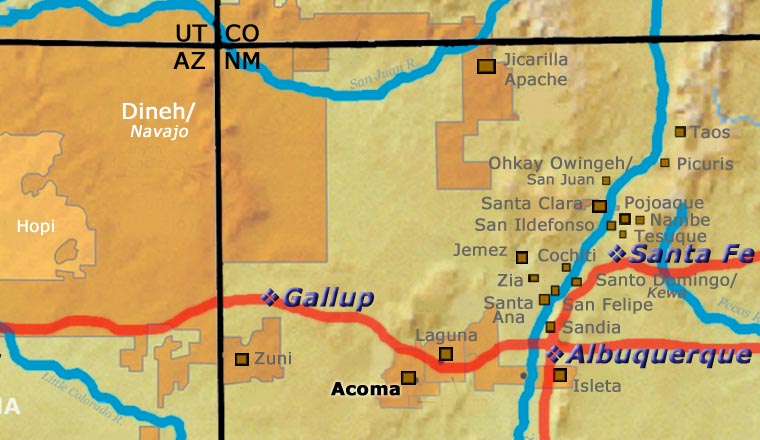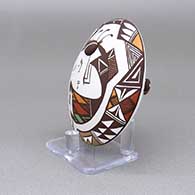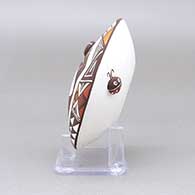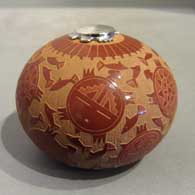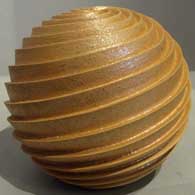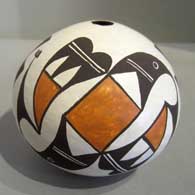
Carolyn Concho
Acoma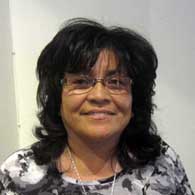
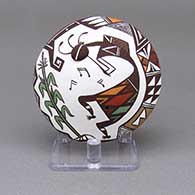
Carolyn Lewis Concho was born into Acoma Pueblo in 1961 as a daughter of Katherine and Edward Lewis. She belongs to the Yellow Corn Clan. After growing up surrounded by some of Acoma's finest potters, she became known as one of the "Five Lewis Sisters of Acoma": Rebecca Lucario, Marilyn Ray, Judy Lewis, Carolyn Concho and Diane Lewis. Actively producing pottery since 1984, Carolyn credits her older sisters with helping her make the decision to become a pottery artist.
As she uses only natural materials to create her pottery, Carolyn gathers her clay, minerals, and plants for pigments on the lands of Acoma Pueblo. She soaks the clay, cleans, mixes, hand coils, sands, paints her designs, and then finishes the process by kiln-firing her pottery.
Carolyn's creations always start with animals that are fashioned after ancient Mimbres designs. Many believe that some of the prehistoric Mimbres people migrated to Acoma Pueblo. Her trademark is a tactile element on her seed pots and plates, such as an ear or head of a rabbit that three-dimensionally pops out of the surface, rendering a realistic effect and adding a bit of whimsy. She decides the placement of the creatures and surrounds the figures with fine black-line designs. Carolyn uses a camel hair brush since she's found that yucca brushes don't glide smoothly enough for her purposes.
She has earned numerous awards at the Heard Museum Indian Art & Crafts Show, Eight Northern Indian Pueblos Arts and Crafts Show, New Mexico State Fair, Gallup Intertribal Ceremonial, and the Santa Fe Indian Market. Carolyn signs her pottery "Carolyn Concho, Acoma".
Carolyn has shared the meanings of some of her designs with us:
Butterfly = Beauty, Dragonfly = Messenger, Turtle = Longevity, Hummingbird = Prosperity, Bird = Cloud Swallower, Lady Bug = Good Luck, Fish = Faith, Rabbit = Abundance, Lizard = Curiosity, Kokopeli = Fertility
100 West San Francisco Street, Santa Fe, New Mexico 87501
(505) 986-1234 - www.andreafisherpottery.com - All Rights Reserved

Acoma Pueblo
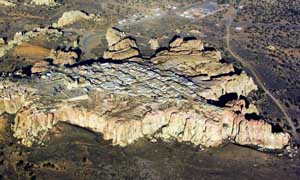
Sky City
According to Acoma oral history, the sacred twins led their ancestors to "Ako," a magical mesa composed mostly of white rock, and instructed those ancestors to make that mesa their home. Acoma Pueblo is called "Sky City" because of its position atop the mesa. Acoma is located about 60 miles west of Albuquerque.
Acoma, Old Oraibi (at Hopi) and Taos all lay claim to being the oldest continuously inhabited community in the U.S. Those competing claims are hard to settle as each village can point to archaeological remnants close by to substantiate each village's claim. While the people of Acoma have an oral tradition that says they've been living in the same area for more than 2,000 years, archaeologists feel more that the present pueblo was established near the end of the major migrations of the 1300s. The location is essentially on the boundary between the Mimbres-Mogollon and Ancestral Puebloan cultures. Each of those cultures has had an impact on the styles and designs of Acoma pottery, especially since modern potters have been getting the inspiration for many of their designs from ancient pot shards they have found while walking on pueblo lands.
Francisco Vasquez de Coronado ascended the cliff to visit Acoma in 1540. He afterward wrote that he "repented having gone up to the place." But the Spanish came back later and kept coming back. In 1598 relations between the Spanish and the Acomas took a really bad turn with the arrival of Don Juan de Oñaté and the soldiers, settlers and Franciscan monks that accompanied him. After ascending to the mesa top, Oñaté decided to force the Acomas to swear loyalty to the King of Spain and to the Pope. When the Acomas realized what the Spanish meant by that, a group of Acoma warriors attacked a group of Spanish soldiers and killed 11 of them, including one of Oñaté's nephews. Don Juan de Oñaté retaliated by attacking the pueblo, burning most of it and killing more than 600 people. Another 500 people were imprisoned by the Spanish, males between the ages of 12 and 25 were sold into slavery and 24 men over the age of 25 had their right foot amputated. Many of the women over the age of 12 were also forced into slavery and were eventually parceled out among Catholic convents in Mexico City. Two Hopi men were also captured at Acoma and, after having one hand cut off, they were released and sent home to spread the word about Spain's resolve to subjugate the inhabitants of Nuevo Mexico.
When word of the massacre and the punishments meted out got back to King Philip in Spain, he banished Don Juan de Oñaté from Nuevo Mexico. Some Acomas had escaped that fateful Spanish attack and returned to the mesa top in 1599 to begin rebuilding. In 1620 a Royal Decree was issued which established civil offices in each pueblo and Acoma had its first governor appointed. By 1680, the situation between the pueblos and the Spanish had deteriorated again to the point where the Acomas were extremely willing participants in the 1680 Pueblo Revolt.
After the successful Pueblo Revolt the Spanish retreated back to Mexico. Refugees from other pueblos began to arrive at Acoma, fearing an eventual Spanish return and reprisals. That strained the resources of Acoma until the Spanish actually did return. The residents of the pueblo had to make a hard decision. Many of the refugees chose to try a peaceful solution: they quickly relocated to the ancient Laguna area and made peace with the Spanish as soon as they appeared in the region.
Over the next 200 years, Acoma suffered from breakouts of smallpox and other European diseases to which they had no immunity. At first they sided with the Spanish against nomadic raiders from the Ute, Apache and Comanche tribes. Then New Mexico changed hands, the railroads arrived and Acoma became dependent on goods brought in from the outside world.
For many years the villagers had been content on the mesa top. Now most live in villages on the valley floor where water, electricity and other necessities are easily available. While a few families still make their permanent home on the mesa top, the old pueblo is used almost exclusively for ceremonies and celebrations these days.
It's the dense, slate-like clay, that allows Acoma pottery to be thin, lightweight and durable. After they form a pot, they paint it with a white slip. Once dry, black and red design motifs are added using mineral and plant derived paints. Fine lines, geometrics, parrots and old Mimbres designs are common motifs. The traditional paintbrush is chewed from the yucca leaf. Historically, Acoma was known for large, thin-walled "ollas," jars used for storing food and water. With the arrival of the railroad and tourists in the 1880s, Acoma potters adapted the size, shapes and styles of their pots in order to appeal to the new buyers.
Acoma potters felt it was an inappropriate display of ego to sign a pot up into the mid-1960s. Then Lucy Lewis, Jessie Garcia and Marie Z. Chino started signing their pots. The 1960s is also a time when the primary Acoma white clay vein passed through a layer of widely distributed impurities, impurities that passed through the clay filtering process and showed up only during and after the firing. The problem was so bad it affected virtually every Acoma potter and every pot they made. Thankfully, by the late 1960s they had dug through that layer of clay and into a deeper layer that didn't have the problem.
100 West San Francisco Street, Santa Fe, New Mexico 87501
(505) 986-1234 - www.andreafisherpottery.com - All Rights Reserved

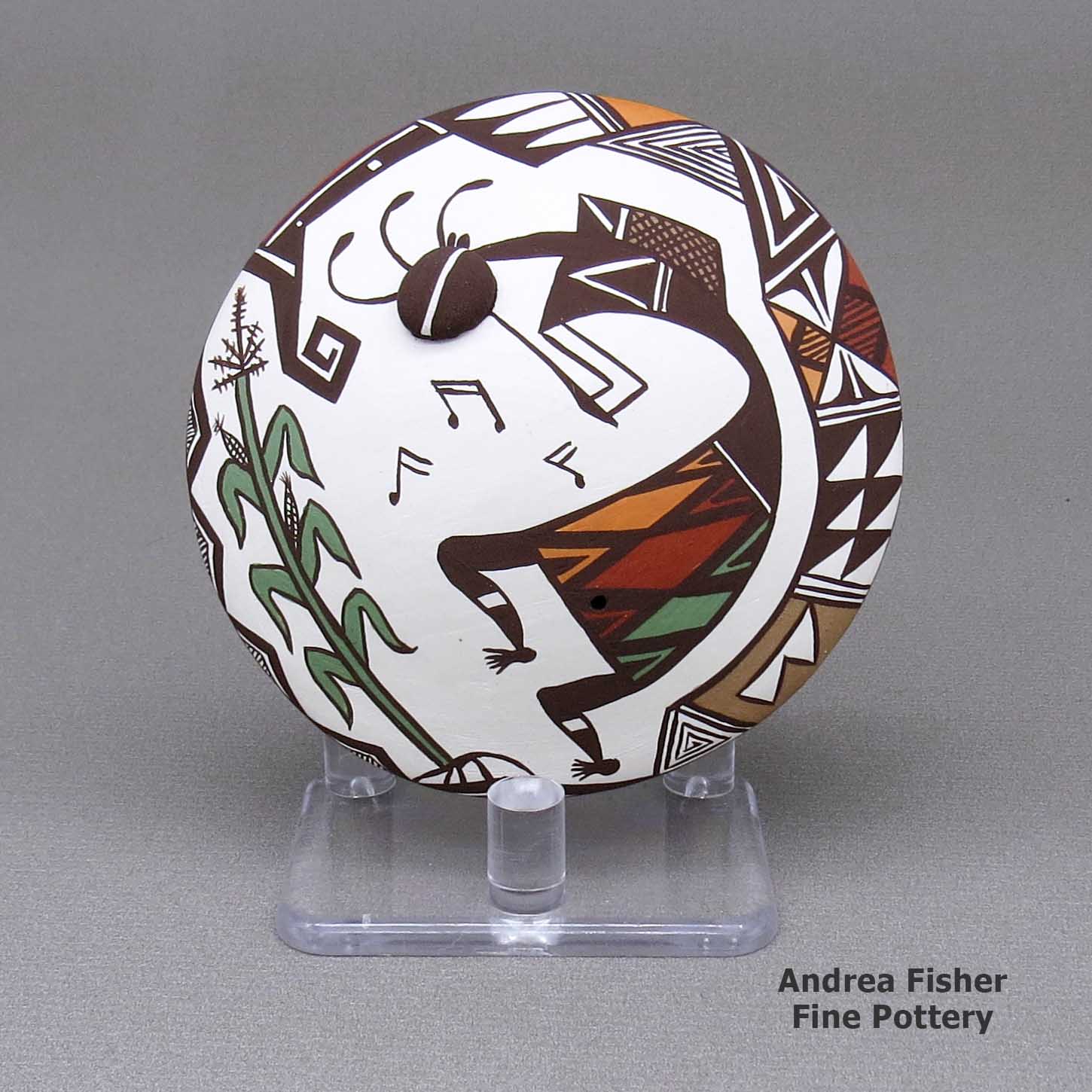
Carolyn Concho, Acoma, Polychromeseedpotwithanappliqueandpaintedkokopelli,cornstalk,musicnote,fineline,andgeometricdesignontopandanappliqueladybugdetailonbottom
Acoma
$ 250
zzac3j158m7
Polychrome seed pot with an applique and painted kokopelli, cornstalk, music note, fine line, and geometric design on top and an applique ladybug detail on bottom
2.75 in L by 2.75 in W by 1 in H
Condition: Excellent
Signature: Carolyn Concho Acoma, NM, with lizard and cornstalk hallmarks
Date Created: 2023
100 West San Francisco Street, Santa Fe, New Mexico 87501
(505) 986-1234 - www.andreafisherpottery.com - All Rights Reserved

Seed Pots
Acoma, Hopi, Isleta, Jemez, Laguna, San Felipe, San Ildefonso, San Juan, Santa Clara
Acoma Pueblo
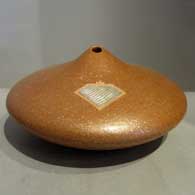
Hopi
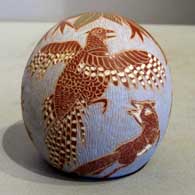
Santa Clara Pueblo
It was a matter of survival to the ancient Native American people that seeds be stored properly until the next planting season. Small, hollow pots were made to ensure that the precious seeds would be kept safe from moisture, light and rodents. After seeds were put into the pot, the small hole in the pot was plugged. The following spring the plug was removed and the seeds were shaken from the pot directly onto the planting area.
Today, seed pots are no longer necessary due to readily available seeds from commercial suppliers. However, seed pots continue to be made as beautiful, decorative works of art. The sizes and shapes of seed pots have evolved and vary greatly, depending on the vision of Clay Mother as seen through the artist. The decorations vary, too, from simple white seed pots with raised relief to multi-colored painted, raised relief and sgraffito designs, sometimes with inlaid gemstones and silver lids.
100 West San Francisco Street, Santa Fe, New Mexico 87501
(505) 986-1234 - www.andreafisherpottery.com - All Rights Reserved

Delores Sanchez Family Tree
Disclaimer: This "family tree" is a best effort on our part to determine who the potters are in this family and arrange them in a generational order. The general information available is questionable so we have tried to show each of these diagrams to living members of each family to get their input and approval, too. This diagram is subject to change should we get better info.
- Delores Sandoval Sanchez (ca. 1888-1991) & Toribio Sanchez
- Marie S. Juanico (1937-)
- Delores Aragon (Juanico) (1969-)
- Katherine Lewis (1932-)
- Bernard Lewis (1957-) & Sharon Lewis (1959-)
- Eric Lewis (1978-)
- Carolyn Concho (1961-)
- Alisha Sanchez & George Concho, Jr.
- Shaylene Chino
- Alisha Sanchez & George Concho, Jr.
- Diane Lewis (1959-)
- Judy Lewis (1966-)
- Rebecca Lucario(1951-)
- Amanda Lucario (1984-)
- Daniel Lucario (1969-)
- Marilyn Ray (1954-)
- Edward Lewis Jr. & Eva Concho
- Edward Lewis III
- Bernard Lewis (1957-) & Sharon Lewis (1959-)
- Ethel Shields (1926-) & Don Shields
- Charmae Shields Natseway (1958-) & Thomas Natseway (1953-)(Laguna)
- Chris Shields & Michelle Shields (1972-)
- Curtis Shields
- Isaac Shields
- Natasha Shields
- Jack Shields (c.1961-)
- Judy Shields (daughter-in-law)
- Verda Mae Shields (daughter-in-law)
Some of the above info is drawn from Southern Pueblo Pottery, 2000 Artist Biographies, by Gregory Schaaf, © 2002, Center for Indigenous Arts & Studies
Other info is derived from personal contacts with family members and through interminable searches of the Internet and cross-examination of the data found.
(505) 986-1234 - www.andreafisherpottery.com - All Rights Reserved


